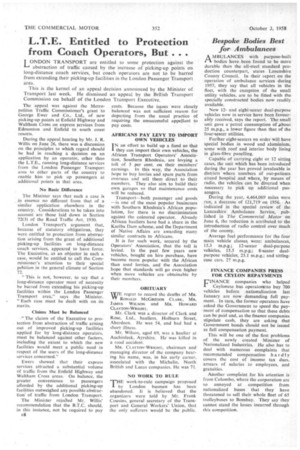Bespoke Bodies Best for Ambulances
Page 80

If you've noticed an error in this article please click here to report it so we can fix it.
AMBULANCES with purpose-built bodies have been found to be more durable than the all-steel standard production counterpart, states Lancashire County Council. In -their teport on the operation of ambulance services during 1957; they say that all vehicles in the fleet, with the exception of the small utility vehicles, are to be fitted with the specially constructed bodies now readily available.
New 12and eight-seater dual-purpose vehicles now in service have been favourably received, says the report. The small unit gave a• petrol consumption of About 25 m.p.g., a lower figure than that of the four-seater utilities.
Further eight-seaters on order will have special bodies in wood and aluminium, some with roof and interior body lining in glass-fibre panelling.
' Capable of 'carrying eight or 12 sitting cases, the unit which has been introduced during the year has proved invaluable in districts where numbers of out-patients attend hospital and where, by means 'of radio, the vehicles, can be diverted when necessary to pick up additional passengers.
During the year, 4,464,069 miles were run, a decrease of 121,719 on 1956. As indicated in the special review of the Lancashire Ambulance Service, published in The Commercial Motor on June 6, the reduction is attributed to the introduction of radio control over much of the county.
Average fuel performance for the four main vehicle classes, were: ambulances, 15.3 m.p.g.; 12-seater dual-purpose vehicles, 15.5 m.p.g.; 8-seater dualpurpose vehicles, 23.1 m.p.g.; and sittingcase cars, 27 m.p.g.
FINANCE COMPANIES PRESS FOR CEYLON REPAYMENTS
FINANCE companies who helped Ceylonese bus operators to buy 700 vehicles before nationalization last January. are now demanding full payment. In turn, the former operators have asked the Government to speed the payment of compensation so that these debts can be paid and, as the finance companies stipulate cash, they are asking that Government bonds should not be issued as full compensation payment.
This will he one of the first problems of the newly created Minister of Nationalized Industries. He also has to deal with numerous complaints that recommended compensation hardly covers the cost of income tax dues, arrears of salaries to employees, and gratuities.
Another complaint for his attention is from Colombo, where the corporation are so annoyed at competition from nationalized buses that they have threatened to sell their whole fleet of 65 trolleybuses to Bombay. They say they cannot stand the losses incurred through this competition.
















































































































































































